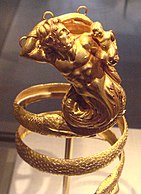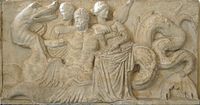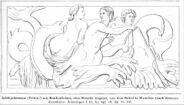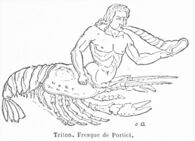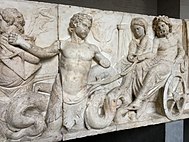Triton (mythology)
Topic: Religion
 From HandWiki - Reading time: 16 min
From HandWiki - Reading time: 16 min
| Triton | |
|---|---|
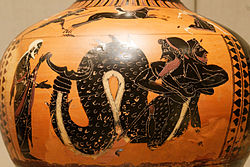 Attic black-figure hydria, depicting Triton fought by Heracles. | |
| Abode | Sea |
| Symbol | Conch shell |
| Personal information | |
| Parents | Poseidon and Amphitrite |
| Siblings | Rhodos, Benthesikyme, and several paternal half-siblings |
| Consort | Libya |
| Children | Triteia, Pallas, Calliste |
Triton is usually represented as a merman, with the upper body of a human and the tailed lower body of a fish. At some time during the Greek and Roman era, Triton(s) became a generic term for a merman (mermen) in art and literature. In English literature, Triton is portrayed as the messenger or herald for the god Poseidon.
Triton of Lake Tritonis of ancient Libya is a namesake mythical figure that appeared and aided the Argonauts. Moreover, according to Apollonius Rhodius, he married the Oceanid of said region, Libya.
Sea god
Triton was the son of Poseidon and Amphitrite according to Hesiod's Theogony.[1][2] He was the ruler (possessor) of the depths of the sea,[1] who is either "dreadful" or "mighty" (δεινός) according to the epithet given him by Hesiod.[1][3]
Triton dwelt with his parents in underwater golden palaces.[1] Poseidon's golden palace was located at Aegae on Euboea in one passage of Homer's Iliad 12.21.[4][5][6][lower-alpha 1]
Unlike his father Poseidon who is always fully anthropomorphic in ancient art (this has only changed in modern popular culture), Triton's lower half is that of a fish, while the top half is presented in a human figure.
Triton in later times became associated with possessing a conch shell,[7] which he blew like a trumpet to calm or raise the waves.[9] He was "trumpeter and bugler" to Oceanus and Poseidon.[10] Its sound was so cacophonous that when loudly blown, it put the giants to flight, who imagined it to be the roar of a dark wild beast.[11]
The original Greek Triton only sometimes bore a trident.[12] In literature, Triton carries a trident in Accius's Medea fragment.[13][14][lower-alpha 2]
Triton is "sea-hued" according to Ovid and "his shoulders barnacled with sea-shells".[17] Ovid actually here calls Triton "cerulean" in color, to choose a cognate rendering to the original language (Latin: caeruleus);[18][19] Ovid also includes Triton among other deities (Proteus, Aegaeon, Doris) of being this blue color, with green (viridis) hair,[20][21] as well describing the steed Triton rides as cerulean.[23]
Libyan lake god
There is also Triton, the god of Lake Tritonis of Ancient Libya encountered by the Argonauts. This Triton is treated as a separate deity in some references.[24][7] He had a different parentage, as his father was Poseidon but his mother Europa according to the Greek writers of this episode.[26]
This Triton first appeared in the guise of Eurypylus before eventually revealing his divine nature.[27] This local deity has thus been euhemeristically rationalized as "then ruler over Libya" by Diodorus Siculus.[28]
Triton-Eurypylus welcomed the Argonauts with a guest-gift of a clod of earth which was a pledge that the Greeks would be granted the land of Cyrene, Libya in the future.[7] The Argo had been driven ashore in the Syrtes (Gulf of Syrtes Minor according to some), and Triton guided them through the lake's marshy outlet back to the Mediterranean.[27][29]
One of the works which recounts this adventure is Apollonius of Rhodes' Argonautica (3rd century BC), the first work in written literature that describes a Triton as "fish-tailed".[30]
Triton with men and heroes
In Virgil's Aeneid, book 6, it is told that Triton killed Misenus, son of Aeolus, by drowning him after he challenged the gods to play as well as he did.[31][7]
Iconography of Triton duels
Herakles wrestling Triton is a common theme in Classical Greek art particularly black-figure pottery,[32] but no literature survives that tells the story.[33] In fewer examples, the Greek pottery depicting apparently the same motif are labeled "Nereus" or "Old Man of the Sea" instead, and among these, Nereus' struggle with Herakles is attested in literature (Pseudo-Apollodorus, Bibliotheca).[34] "Old Man of the Sea" is a generic term applicable to Nereus, who was also frequently depicted as half-fishlike.[34][35] One explanation is that some vase painters developed the convention of depicting Nereus as a fully human form, so that Triton had to be substituted in the depiction of the sea-monster wrestling Herakles. And Nereus appears as a spectator in some examples of this motif.[36]
In the red-figure period, the Triton-Herakles theme became completely outmoded, supplanted by such scenes as Theseus's adventures in Poseidon's golden mansion, embellished with the presence of Triton.[32] Again, extant literature describing the adventure omits any mention of Triton,[37] but placement of Triton in the scene is not implausible.[32]
Further genealogy
Triton was the father of a daughter named Pallas and foster parent to the goddess Athena, according to Pseudo-Apollodorus's Bibliotheca.[lower-alpha 3][39] Elsewhere in the Bibliotheca, there appears a different Pallas (Giant), a male figure overcome by Athena.[lower-alpha 4][40]
Athena bears the epithet Tritogeneia (Τριτογένεια) "Triton-born"[42] and while this is suggestive of Triton's daughter being Athena,[43] the appellation is otherwise explainable in several ways, e.g., as Athena's birth (from Zeus's head) taking place at the River Triton or Lake Tritonis.[44]
Triton also had a daughter named Triteia. According to Pausanias writing in the 2nd century CE, one origin story of the city of Triteia held that this was an eponymous city after Triteia, founded by her and Ares's son, named Melanippus ("Black Horse").[45]
Tritons
At some time during the Greco-Roman period, "Tritons", in the plural, came to be used a generic term for mermen.[2]
Hellenistic and Roman art
Greek pottery depicting a half-human, half-fish being bearing an inscription of "Triton" is popular by the 6th century BC.[30] It has also been hypothesized that by this time "Triton" has become a generic term for a merman.[46][lower-alpha 5]
Furthermore, Tritons in groups or multitudes began to be depicted in Classical Greek art by around the 4th century BC.[lower-alpha 6][47] Among these is the work by Greek sculptor Scopas (d. 350 BC) which was later removed to Rome.[48] The sirens of Homer's Odyssey were sometimes being depicted, not as human-headed birds but as tritonesses by around this time, as seen in a bowl dated to the 3rd century BC,[lower-alpha 7] and this is explained as a conflation with Odysseus's Scylla and Charybdis episode.[49][50]
Though not a contemporaneous inscription or commentary, Pliny (d. 79 CE) commented on the work that "there are Nereids riding on dolphins… and also Tritons" in this sculpture.[51]
In later Greek periods into the Roman period Tritons were depicted as ichthyocentaurs, i.e., merman with a horse's forelegs in place of arms. The earliest known examples are from the 2nd century BC.[lower-alpha 8][52] The term "Ichthyocentaur" did not originate in Ancient Greece, and only appeared in writing in the Byzantine period (12th century); "Centaur-Triton" is another word for a Triton with horse-legs.[8][53]
Besides examples in which the horse-like forelimbs have been replaced by wings,[53] there are other examples where the forelegs have several clawed digits (somewhat like lions), as in one relief at the Glyptothek in Munich, Germany.[54][55] A Triton with a lower extremity like a lobster or crayfish, in a fresco unearthed from Herculanum has been mentioned.[57][56]
Double-tailed tritons began to be depicted by the late 2nd century BC, such as in the Altar of Domitius Ahenobarbus. Rumpf thought that might be the earliest example of a "Triton with two fish-tails (Triton mit zwei Fischschwänzen)".[58] However the double-tailed tritonesses in Damophon's sculptures at Lycosura predates it, and even this is doubted to be the first example.[59] Lattimore believed the two-tailed triton should be dated to the 4th century BC, and speculated that Skopas was the one to devise it.[60][62]
As aforementioned, there is the female version of the half-human, half-fishlike being, sometimes called a "tritoness"[63] or a "female triton".[64]
Literature in the Roman period
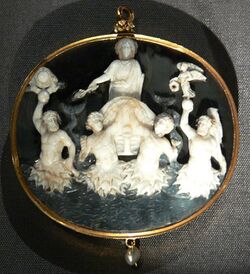
The first literary attestation of Tritons (Latin: Trītōnēs) in the plural was Virgil's Aeneid (c. 29–19 BC).[48][65] In the 1st century CE, another Latin poet Valerius Flaccus wrote in Argonautica that there was a huge Triton at each side of Neptune's chariot, holding the reins of horses.[66][22] And Statius (1st century) makes a Triton figurehead adorn the prow of the Argo.[68]
Trions and nereids appear as marine retinues (Latin: marinum obsequium) to the goddess Venus in Apuleius's Metamorphoses, or "The Golden Ass".[69]
Pausanias
Tritons (Greek: Τρίτωνες, romanized: Trítōnes) were described in detail in the 2nd century CE by Pausanias (ix. 21).[70][8]
The Tritons have the following appearance. On their heads they grow hair like that of marsh frogs (Greek: βατράχιον, plants of the Ranunculus or buttercup genus[lower-alpha 9]) not only in color, but in the impossibility of separating one hair from another. The rest of their body is rough with fine scales just as is the shark. Under their ears they have gills and a man's nose; but the mouth is broader and the teeth are those of a beast. Their eyes seem to me blue,[lower-alpha 10] and they have hands, fingers, and nails like the shells of the murex. Under the breast and belly is a tail like a dolphin's instead of feet.
Pausanias was basing his descriptions on a headless Triton exhibited in Tanagra and another curiosity in Rome. These Tritons were preserved mummies or taxidermied real animals or humans (or fabrication made to appear as such).[72][73] The Tanagran Triton was seen by Aelian who described it as an embalmed or stuffed mummy (Greek: τάριχος).[74] While Pausanias related a legend around the Tanagran Triton that its head was cut off, J. G. Frazer conjectured that such a cover story had to be invented after a sea mammal's carcass with a severed or severely mutilated head was passed off as a Triton.[73][lower-alpha 11]
Renaissance
Triton was referred to as "trumpeter of Neptune (Neptuni tubicen)" in Cristoforo Landino (d. 1498)'s commentary on Virgil;[76] this phrasing later appeared in the gloss for "Triton" in Marius Nizolius's Thesaurus (1551),[77] and Konrad Gesner's book (1558).[78]
Triton makes appearance in English literature as the messenger for the god Poseidon.[79] In Edmund Spenser's Faerie Queene, Triton blew "his trompet shrill before" Neptune and Amphitrite.[79][80] And in Milton (1637), "Lycidas" v. 89, "The Herald of the Sea" refers to Triton.[81]
Gianlorenzo Bernini sculpted the "Neptune and Triton" fountain (1622–23) now in the Victoria and Albert Museum[82][83] and the Triton Fountain (1642–43) in Bernini Square, Rome.[84][85] There is differing opinion on what earlier works he may have drawn from near-contemporary works or examples from antiquity. He may have been influenced by Battista di Domenico Lorenzi's Alpheus and Arethusa (1568–70) or his Triton blowing the conch (late 1570s),[86] or Stoldo Lorenzi's Neptune fountain.[87] But Rudolf Wittkower has cautioned against exaggerating the influences of Florentine fountains.[87] It has been pointed out that Bernini had access to the Papal collection[lower-alpha 12] of genuine Greco-Roman sculptures, and worked with restoring ancient fragments,[90] although it is unclear if any Triton was among these. It is within the realm of possibilities that Bernini might have used as his model the ancient Altar of Domitius Ahenobarbus, which does include Triton in its composition.[91] The Triton of this altar, the Stoldo Lorenzi Triton and the Bernini Triton are all double-tailed, like a pair of human legs.[92]
Romantic era
In Wordsworth's sonnet "The World Is Too Much with Us" (c. 1802, published 1807), the poet regrets the prosaic humdrum modern world, yearning for
glimpses that would make me less forlorn;
Have sight of Proteus rising from the sea;
Or hear old Triton blow his wreathèd horn.
Mascot
There are numerous universities, colleges, and high schools and businesses that use Triton as their mascot. These include the following:
- University of California, San Diego, La Jolla, California
- Eckerd College, St. Petersburg, Florida
- Edmonds College, Lynnwood, Washington
- Iowa Central Community College, Fort Dodge, Iowa
- Mariner High School, Cape Coral, Florida
- Notre Dame Academy, Green Bay, Wisconsin
- San Clemente High School (San Clemente, California)
- University of Guam, Mangilao, Guam
- University of Missouri–St. Louis
- University of Rennes 1, Brittany France
Many club sports teams, especially swimming leagues, use the symbol of Triton.
- Drew Marine, a leading maritime company, also uses the symbol
Eponyms
The largest moon of the planet Neptune has been given the name Triton, as Neptune is the Roman equivalent of Poseidon. A family of large sea snails, the shells of some of which have been used as trumpets since antiquity, are commonly known as "tritons", see Triton (gastropod).
The name Triton is associated in modern industry with tough hard-wearing machines such as the Ford Triton engine and Mitsubishi Triton pickup truck.
The USS Triton (SSN-586) was the only attack submarine of her class, and the only US Navy nuclear-powered submarine to have two reactors. She was decommissioned in 1969 and languished awaiting scrapping until 2007, which began at Puget Sound Naval Shipyard, and was completed as of 30 November 2009.
Explanatory notes
- ↑ Homer Iliad 8.203 also mentions "Aegaea" but this refers to Aegae (Achaea).[6]
- ↑ A triton (see §Tritons below) and merman are synonymous in heraldry,[15] and the figure may often carry a trident.[16]
- ↑ In this story, Pallas was inadvertently killed by Athena during sparring, and the goddess subsequently took a wooden figurine of Pallas and wrapped the Aegis (goat-skin) around it, thus creating the palladium.
- ↑ In Apollod. 1.6, Frazer ed., the Pallas who Athena slew and whose flayed skin she used as shield-covering, which DGRBM says was a giant ( "Pallas (3)").[40] Cf. Frazer, note 8 and DGRBM "Pallas (5)".[41][40]
- ↑ As aforementioned, "Triton" is the most common label, but "Nereus", and "Old Man of the Sea" are found as inscriptions in six century pottery depicting the motif of Herakles wrestling a sea-monster.[34]
- ↑ Excepting Etruscan art, which has older examples.
- ↑ Mold-made Megarian bowl from Cistern on Areopagus. Excavation of the Athenian Agora, catalogued P 18,640.
- ↑ Among the relief groups in the Pergamon Altar.
- ↑ Translated as "parsley which grows in marshes" by Taylor.[71]
- ↑ Greek: γλαυκός. Defined "freq. of the eye, light blue, grey", in Liddle-Scott-Jones, "γλαυκός".
- ↑ Tritons were the aquatic versions of Satyrs and Centaur "relicts", i.e., creatures purported to exist and exhibited in Greek and Roman times.[75]
- ↑ As a favorite of Paul V (d. 1621).[88] Urban VIII (elected 1623) became his great patron.[89]
References
- Citations
- ↑ 1.0 1.1 1.2 1.3 Hesiod, Theogony 930-933.
- ↑ 2.0 2.1 Hansen, William F. (2004). Deities, Themes and Concepts: Waters. ABC-CLIO. ISBN 9-781-5760-7226-4. https://books.google.com/books?id=1Z-LIKN0Ap0C&pg=PA316.
- ↑ Mommsen (2014), pp. 53, 55.
- ↑ Template:Cite Iliad (text@Perseus Project)
- ↑ Hesiod (1966), West, Martin Litchfield, ed., Theogony, Clarendon Press, p. 414, ISBN 9780198141693, https://books.google.com/books?id=8NZfAAAAMAAJ
- ↑ 6.0 6.1 "Dictionary of Greek and Roman Geography (1854), AEGAE". https://www.perseus.tufts.edu/hopper/text?doc=Perseus:text:1999.04.0064:entry=aegae-geo&highlight=aegae.
- ↑ 7.0 7.1 7.2 7.3 Arafat, Karim (KWA) (2012). "Triton". Triton. Princeton University Press. p. 236. ISBN 978-0-199-54556-8. https://books.google.com/books?id=9TwhfvU08UcC&pg=PA236.
- ↑ 8.0 8.1 8.2 8.3
 Smith, William, ed (1870). "Triton (1)". Dictionary of Greek and Roman Biography and Mythology. https://www.perseus.tufts.edu/hopper/text?doc=Perseus%3Atext%3A1999.04.0104%3Aentry%3Dtriton-bio-1.
Smith, William, ed (1870). "Triton (1)". Dictionary of Greek and Roman Biography and Mythology. https://www.perseus.tufts.edu/hopper/text?doc=Perseus%3Atext%3A1999.04.0104%3Aentry%3Dtriton-bio-1.
- ↑ Ovid, Metamorphoses 1.333 apud DGRBM[8]
- ↑ 10.0 10.1 Conti, Natale (2006). Natale Conti's Mythologiae. 2. ACMRS, Arizona Center for Medieval and Renaissance Studies. p. 708. ISBN 0-866-98361-9. https://books.google.com/books?id=aNIoAAAAYAAJ.
- ↑ Pseudo-Hyginus, Poetical astronomy ii. 23 apud DGRBM[8]
- ↑ Ashton, John (1890). Curious Creatures in Zoology. London: John C. Nimmo. p. 210. https://archive.org/details/curiouscreature00ashtgoog.
- ↑ Seneca (1987). Fitch, John G.. ed. Seneca's "Hercules furens". Cornell University Press. p. 266. ISBN 978-0-801-41876-1. https://archive.org/details/senecasherculesf00fitc.
- ↑ Slaney, Helen (2019). Seneca: Medea. Companions to Greek and Roman Tragedy. Bloomsbury Publishing. pp. 51–52. ISBN 978-1-474-25863-0. https://books.google.com/books?id=YqJ-DwAAQBAJ&pg=PA51.
- ↑ Moule, Thomas (1842). Heraldry of Fish: Notices of the Principal Families Bearing Fish in Their Arms. J. Van Voorst. p. 218. https://archive.org/details/heraldryoffishno00mouluoft.
- ↑ Eve, George W. (1907). "Heraldic birds and other figures". Heraldry as Art: An Account of Its Development and Practice, Chiefly in England. Batsford. p. 95. https://books.google.com/books?id=PbMgAAAAMAAJ&pg=PA95.
- ↑ Ovid (2008). Kenney, E. J.. ed. 1. 332 Deucalion and Pyrrha. Oxford University Press. p. 11. ISBN 978-0-199-53737-2. https://books.google.com/books?id=UwQUDAAAQBAJ&pg=PA11.
- ↑ Ovid (2010). Kenney, E. J.. ed. 1. 332 Deucalion and Pyrrha. Hackett Publishing. p. 15. ISBN 978-1-603-84497-0. https://books.google.com/books?id=mwMLFWjHpQIC&pg=PA15.
- ↑ Ovid, Metamorphoses 1.332
- ↑ Ovid, Metamorphoses 2.8
- ↑ Ovid (2005). 2 Phaëton. Bernard M. W. Knox. W. W. Norton & Company. p. 51. ISBN 0-393-07243-6. https://books.google.com/books?id=j94BT0YjbfMC&pg=PA51.
- ↑ 22.0 22.1 Kleywegt, A. J. (2005). Valerius Flaccus, Argonautica, Book I: A Commentary. BRILL. p. 396. ISBN 9-004-13924-9. https://books.google.com/books?id=zc1eBDc8k2kC&pg=PA396.
- ↑ Ovid, Heroides 7.49–50: "caeruleis Triton per mare curret equis".[10][22]
- ↑
 Smith, William, ed (1870). "Triton (2)". Dictionary of Greek and Roman Biography and Mythology. https://www.perseus.tufts.edu/hopper/text?doc=Perseus%3Atext%3A1999.04.0104%3Aentry%3Dtriton-bio-2.
Smith, William, ed (1870). "Triton (2)". Dictionary of Greek and Roman Biography and Mythology. https://www.perseus.tufts.edu/hopper/text?doc=Perseus%3Atext%3A1999.04.0104%3Aentry%3Dtriton-bio-2.
- ↑ Jackson, Steven (1987), "Apollonius' Argonautica: Euphemus, a Clod and a Tripod", Illinois Classical Studies (The American School of Classical Studies at Athens) 12 (1): pp. 23–30, https://www.ideals.illinois.edu/bitstream/handle/2142/12110/illinoisclassica121987JACKSON.pdf?sequence=2&isAllowed=y
- ↑ Pindar, Pythian 4. 45, Apollonius Argonautica I.179181). Jackson (1987), pp. 27, 28[25]
- ↑ 27.0 27.1 Pindar, Pythian 4; Apollonius Rhodius, Argonautica, iv. 1552ff; .
- ↑ Diodorus iv.56.6.
- ↑ Jackson (1987), p. 23.
- ↑ 30.0 30.1 Lattimore (1976), p. 56.
- ↑ Virgil, Aeneid 6.164 ff..
- ↑ 32.0 32.1 32.2 Mommsen (2014), pp. 55.
- ↑ Norris, Michael Byron (2000). Greek Art: From Prehistoric to Classical : a Resource for Educators. Metropolitan Museum of Art. p. 172. ISBN 0-870-99972-9. https://books.google.com/books?id=7UnxdSXZkuoC&pg=PA172.
- ↑ 34.0 34.1 34.2 Pedley, John Griffiths (1970). "The Friedlaender Hydria". Harvard Studies in Classical Philology 74: 48–49. doi:10.2307/310997. https://books.google.com/books?id=gzxMAAAAYAAJ.
- ↑ Pulliam, Susan Elizabeth (1977). Problems of Metamorphosis in Greek Black-figure Vase-painting (Thesis). University of California, Berkeley. p. 6–8.
- ↑ Padgett, J. Michael (1988). The painted past: 28 Attic vases, 6th and 5th centuries B.C., from the Museum of Fine Arts, Boston. Utah Museum of Fine Arts, University of Utah. p. 19. https://books.google.com/books?id=WLbkAAAAMAAJ8.
- ↑ Bacchylides 17, Hygnius Poeticon astronomicon 2.5, Pausanias 1. 17.3, apud Mommsen (2014), pp. 55
- ↑ Picón, Carlos A.; Hemingway, Seán (2016). Pergamon and the Hellenistic Kingdoms of the Ancient World. Metropolitan Museum of Art. p. 231. ISBN 9781588395870. https://books.google.com/books?id=Vr3WCwAAQBAJ&pg=PA231.
- ↑ Apollod. 3.12.6; or 3.144: Apollodorus' Library and Hyginus' Fabulae: Two Handbooks of Greek MythologyI. Hackett Publishing. 2007. p. 62. ISBN 9-781-60384-052-1. https://books.google.com/books?id=s8pgDwAAQBAJ&pg=PA62.
- ↑ 40.0 40.1 40.2
 Smith, William, ed (1870). "Pallas (3)". Dictionary of Greek and Roman Biography and Mythology. https://www.perseus.tufts.edu/hopper/text?doc=Perseus:text:1999.04.0104:entry=pallas-bio-3.
Smith, William, ed (1870). "Pallas (3)". Dictionary of Greek and Roman Biography and Mythology. https://www.perseus.tufts.edu/hopper/text?doc=Perseus:text:1999.04.0104:entry=pallas-bio-3.
- ↑
 Smith, William, ed (1870). "Pallas (5)". Dictionary of Greek and Roman Biography and Mythology. https://www.perseus.tufts.edu/hopper/text?doc=Perseus:text:1999.04.0104:entry=pallas-bio-5.
Smith, William, ed (1870). "Pallas (5)". Dictionary of Greek and Roman Biography and Mythology. https://www.perseus.tufts.edu/hopper/text?doc=Perseus:text:1999.04.0104:entry=pallas-bio-5.
- ↑ Hesiod, Theogony 895. Most tr. (2006), p. 75; Hesiod (2015). Theogony 895. Hackett Publishing. p. 56. ISBN 978-1-585-10603-5. https://books.google.com/books?id=0SEKBgAAQBAJ&pg=PA56.
- ↑ Connelly claims this is so in some sources.
- ↑ Connelly, Joan Breton (2014). The Parthenon Enigma. Alfred A. Knopf. p. 39. ISBN 978-0-307-59338-2. https://archive.org/details/parthenonenigma0000conn.
- ↑ Pausanias. "Description of Greece VII 22.8". Harvard University Press. http://data.perseus.org/citations/urn:cts:greekLit:tlg0525.tlg001.perseus-eng1:7.22.8.
- ↑ Lattimore (1976), p. 56: "By the sixth century, to judge from inscriptions on vases, 'Triton' was the most popular designation for the merman".
- ↑ Lattimore (1976), p. 30: "The next stage—pluralization of Triton (originally a god) ... is not attested before the fourth century except in Etruscan art."
- ↑ 48.0 48.1 Robinson, David M. (1926). Roman Sculptures from Colonia Caesarea: (Pisidian Antioch). College Art Association of America. p. 29. https://books.google.com/books?id=WLbkAAAAMAAJ8.
- ↑ Holford-Strevens, Leofranc (2006), "1. Sirens in Antiquity and the Middle Ages", in Austern, Linda Phyllis; Naroditskaya, Inna, Music of the Siren, Bloomington: Indiana University Press, p. 29, ISBN 9780253112071, https://books.google.com/books?id=5IBSGG9YegwC&pg=PT38
- ↑ Thompson, Homer A. (July–September 1948). "The Excavation of the Athenian Agora Twelfth Season". Hesperia: The Journal of the American School of Classical Studies at Athens 17 (3, The Thirty-Fifth Report of the American Excavation in the Athenian Agora): 161–162 and Fig. 5. doi:10.2307/146874. https://www.ascsa.edu.gr/uploads/media/hesperia/146874.pdf.
- ↑ Pliny (1962), Natural History Volume X: Book XXXVI, Loeb Classical Library 419, Harvard University Press, pp. 20–21
- ↑ Rumpf, Andreas (1939) Die Meerwesen, Reprint (1969), p. 105 and note 140, apud Lattimore (1976), p. 44, note 84.
- ↑ 53.0 53.1 Packard, Pamela M. (1980), "A Monochrome Mosaic at Isthmia", Hesperia (The American School of Classical Studies at Athens) 49 (4): 329, note 7, https://www.ascsa.edu.gr/uploads/media/hesperia/147913.pdf JSTOR 147913
- ↑ 54.0 54.1 Roscher, Wilhelm Heinrich (1890), "Ichthyokentauren" (in de), Ausführliches Lexikon der griechischen und römischen Mythologie (B. G. Teubner) 2: pp. 91–94, https://books.google.com/books?id=1_UUAAAAQAAJ&pg=PA91
- ↑ 55.0 55.1 Overbeck, Johannes Adolf (1878), Griechische Kunstmythologie, 2, pp. 356–357, https://books.google.com/books?id=SWgcAAAAMAAJ&pg=PA356
- ↑ 56.0 56.1 Froehner, Wilhelm, 1834-1925 (1878), "5. Mercure, Jupiter, Cérès" (in fr), Notice de la sculpture antique du Musée Impérial du Louvre (De Mourges): pp. 24–25, https://archive.org/details/noticedelasculpt00louvuoft/page/24
- ↑ Clarac, Frédéric de (1841) (in fr), Musée de sculpture antique et moderne, 2, Imprimerie royale et impériale, pp. 190–191, https://books.google.com/books?id=QlR9ajiHBEAC&pg=PA191
- ↑ Rumpf, Andreas (1939), Die Meerwesen, Reprint (1969), p. 105 (?) apud Lattimore (1976), p. 56
- ↑ Picard, Charles (1948), Manuel d'archéologie grecque: sculpture, p. 684 apud Lattimore (1976), p. 56
- ↑ Lattimore (1976), pp. 60–61.
- ↑ Stewart, A. F. (1978), "(Book Review) The Marine Thiasos in Greek Sculpture by Steven Lattimore", American Journal of Archaeology 82 (2): –261–262, doi:10.2307/504508, https://www.ascsa.edu.gr/uploads/media/hesperia/147913.pdf JSTOR 504508
- ↑ Skopa's sculpture is long lost. Cf. A. F. Stewart's remark that hypotheses on a lost work causes Lattimore to adopt an equivocal ("might-have-beens"), though Lattimore is uniquely resolute on the "conclusion [that] the double-tailed Triton was probably Skopas's creation (p. 61)".[61]
- ↑ Lattimore (1976), p. 61.
- ↑ Lawrence, Arnold Walter (1972). Greek and Roman sculpture. Harper & Row. p. 196. ISBN 9780064352604. https://archive.org/details/greekromansculpt00lawr.
- ↑ P. Vergilius Maro. Aeneid V. 824. http://data.perseus.org/citations/urn:cts:latinLit:phi0690.phi003.perseus-eng1:5.799-5.826.
- ↑ Gaius Valerius Flaccus (2008). Valerius Flaccus' Argonautica, Book 1: Edited with Introduction, Translation, and Commentary. OUP Oxford. pp. 56–57. ISBN 978-0-199-21949-0. https://books.google.com/books?id=yUETDAAAQBAJ&pg=PA56.
- ↑ Kleywegt (2005), p. 175.
- ↑ Thebaid 5.371f.[67]
- ↑ Kenney, E. J. (1990). Apuleius: Cupid and Psyche. P. E. Easterling. Cambridge University Press. ISBN 0-521-27813-9. https://books.google.com/books?id=bFNK7qX7l9QC&pg=PA44.. Text and translation to 4.31–7, pp. 44–45; endnotes pp. 125–126.
- ↑ Pausanias. "Description of Greece IV, 9.21.2". Harvard University Press. http://data.perseus.org/citations/urn:cts:greekLit:tlg0525.tlg001.perseus-eng1:9.21.1.
- ↑ Pausanias (1824). "The Description of Greece". The Description of Greece. 3 (2 ed.). R. Priestley. p. 40. https://books.google.com/books?id=0wgLAAAAYAAJ&pg=PA40.
- ↑ Mayor (2011), p. 232.
- ↑ 73.0 73.1 73.2 Frazer, J. G. (2012). Pausanias's Description of Greece V: Commentary on Books IX, X. Addenda. Cambridge University Press. pp. 83–85. ISBN 9781108047272. https://books.google.com/books?id=OIv5iPVMyC0C&pg=PA83.
- ↑ Aelian, De Natura Animalium, xiii, 21, apud Frazer[73]
- ↑ Mayor (2011), p. 236.
- ↑ Landinus, Christophorus (1508). Tertius & Quartus in Publij Virgilij Maronis Allegorias. Schurer. p. H iiii. https://books.google.com/books?id=a9VaAAAAcAAJ&pg=PP91.
- ↑ Nizolius, Marius (1551), "Triton", Dictionarium Seu Thesaurus Latinae Linguae (Ex Sirenis Officina): p. 507, https://books.google.com/books?id=QehRAAAAcAAJ&pg=RA39-PA10
- ↑ Gesner, Konrad (1558). [1237} Historiae animalium] (1604 ed.). Lib. IIII, p. 1197. https://gdz.sub.uni-goettingen.de/id/PPN472755935?tify={%22pages%22:[1237]}. Lib. IV, p. 1001.
- ↑ 79.0 79.1 Norton, Daniel Silas (1952). Classical Myths in English Literature. Rinehart & Company. pp. 335–336. https://books.google.com/books?id=Cd4oAAAAYAAJ.
- ↑ Spenser, Edmund (1845). Faerie Queene 4.11.12. Henry Washbourne. p. 232. https://books.google.com/books?id=xhIyAQAAMAAJ&pg=PA232.
- ↑ Milton, John (2009). Revard, Stella P.. ed. Lycidas. John Wiley & Sons. p. 77. ISBN 978-1-405-12926-8. https://books.google.com/books?id=I3P-vTBvZIgC&pg=PA77.
- ↑ Barrow, Rosemary (2018). Gender, Identity and the Body in Greek and Roman Sculpture. Michael Silk. Cambridge University Press. p. 165. ISBN 978-1-108-58386-2. https://books.google.com/books?id=w0JwDwAAQBAJ.
- ↑ Wilkins, Ann Thomas (2000). "Bernini and Ovid: Expanding the Concept of Metamorphosis". International Journal of the Classical Tradition 6 (3): 401–405. JSTOR 30222585
- ↑ Dickerson, Claude Douglas, (III); Sigel, Anthony; Wardropper, Ian (2012). Bernini: Sculpting in Clay. Metropolitan Museum of Art. pp. 36. ISBN 978-1-588-39472-9. https://books.google.com/books?id=6dr1bq99nDgC&pg=PA36.
- ↑ Wilkins (2000), p. 406, n84
- ↑ Wilkins (2000), p. 390 and n24; p. 405, n 82.
- ↑ 87.0 87.1 Wittkower, Rudolf (1997). Gian Lorenzo Bernini: The Sculptor of the Roman Baroque (4th ed.). London: Phaidon Press. p. 22, n5. ISBN 9780801414305. https://books.google.com/books?id=BG7qAAAAMAAJ.
- ↑ Barrow (2018), p. 165.
- ↑ Wilkins (2000), p. 393.
- ↑ Barrow (2018), pp. 165–166.
- ↑ Barrow (2018), pp. 174–175.
- ↑ Barrow (2018), p. 175.
- Bibliography
- Lattimore, Steven (1976). The Marine Thiasos in Greek Sculpture. Institute of Archaeology, University of California, Los Angeles. ISBN 9780917956027. https://books.google.com/books?id=WPo2AQAAIAAJ.
- Mayor, Adrienne (2011). The First Fossil Hunters: Dinosaurs, Mammoths, and Myth in Greek and Roman Times. Princeton University Press. ISBN 978-0-691-15013-0. https://books.google.com/books?id=NmCLOcvMnqwC&pg=PA232.
- Mommsen, Heide (2014). Avramidou, Amalia. ed. Reflections on Triton. Walter de Gruyter GmbH & Co KG. pp. 53–64. ISBN 978-3-110-30881-5. https://books.google.com/books?id=rR7oBQAAQBAJ&pg=PA53.
External links
- Nereid and Triton Mosaic from Ephesus Terrace Home -2
- 3D stereoview of Nereid and Triton relief from Apollon Temple in Didim
- TheoiProject: Triton Classical references to Triton in English translation
- The Warburg Institute Iconographic Database (images of Nereids and Tritons)
 |
 KSF
KSF


